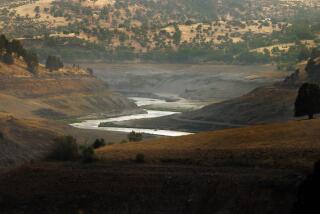Klamath Crisis Overestimated, Study Says
- Share via
Back in the parched year of 2001, the water-starved farmers of the Klamath Basin embraced what seemed a common-sense bit of conventional wisdom. Everyone said that steep cuts that year in irrigation water, which for generations had turned the fertile region into an agricultural oasis each spring, were hitting hard in the pocketbook. By most accounts, the local economy suffered a loss topping $250 million.
But an exhaustive study of the Klamath crisis has concluded the losses weren’t nearly so severe. In fact, the region might even have turned a profit in a year dubbed a disaster.
The 400-page report produced by researchers at Oregon State University and UC Davis estimates that the Klamath Basin, which straddles the Oregon-California border, experienced at worst a loss of $11 million and at best reaped $10 million in gains.
Environmentalists have jumped on that finding as proof of their long-held belief that the 2001 crisis was overblown by the 1,400 farmers who grow potatoes, onions, alfalfa and other crops across the basin’s 235,000 agricultural acres.
But farmers say their pain was indeed genuine and that the economic study, produced by a computer model, failed to reflect the real world.
“Seeing what happened around here, there’s no way anyone is going to accept the notion that 2001 was a wash,” said Dan Keppen, Klamath Water Users Assn. executive director. “These findings reflect the incredible disconnect between folks in an academic setting and those who actually saw what occurred on the ground.”
The Klamath crisis erupted after a dry winter prompted federal officials to cut off irrigation diversions so more water was available for two species of endangered sucker fish in Upper Klamath Lake and coho salmon in the river downstream.
Despite two years of fighting since the crisis erupted, little headway has been made to resolve differences between farmers and a coalition of environmentalists, fishermen and Native American tribes.
Authors of the report acknowledge that the 2001 growing season saw considerable pain in the region. More than half the basin was left dry as irrigation flows were reduced to help the fish, they determined.
But the flood of federal and state assistance that poured into the Klamath region helped offset steep losses. The report estimated that net crop revenue dropped between $27 million and $46 million, while between $35 million and $37 million in government aid went into the pockets of farmers.
The report’s authors note that their estimate did not figure in long-term costs, such as depressed land values and agricultural contracts canceled because of the water shortage. They also said that the real-world costs of the water cutback didn’t evaporate, but rather were shifted from the backs of the farmers to the wallets of taxpayers.
Meanwhile, a separate study of the Klamath crisis by the Wilderness Society determined that the bulk of the farm subsidies during 2001 went to a small percentage of farmers.
The study determined that just 10 farm families in the basin collected nearly 20% of the government subsidy money, with one pair of brothers reaping nearly $900,000. Many of those families helped lead the fight for increased bail-out money, said Pete Rafle of the Wilderness Society. “Those who had the best connections got the most money.”
In addition, farmers who leased agricultural land in federal wildlife refuges in the basin reaped a disproportionate share, Rafle said. The 39 farm families that lease refuge land received nearly a third of the federal funding distributed in 2001, according to the Wilderness Society report.
Environmentalists would like to see farming halted on those refuge lands, which each year serve as habitat for the biggest concentration of migratory birds commuting on the Pacific Flyway. The subsidy money granted refuge farmers in 2001 makes it only tougher to push them off, Rafle said. “These people are profiting handsomely, so they have even more incentive to stick it out.”
Farmers on the refuge lands, considered the most fertile agricultural turf in the entire basin, have long maintained that they suffered considerably in 2001 and the government money only began to blunt the pain. They contend that farming has a place on the refuges because crops serve as food for migratory birds.
More to Read
Sign up for Essential California
The most important California stories and recommendations in your inbox every morning.
You may occasionally receive promotional content from the Los Angeles Times.









